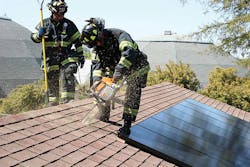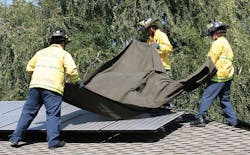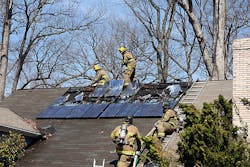Festering fire service worries over the hazards of working around rooftop photovoltaic (PV) installations are beginning to see the light of day. They’re being reflected in notable revisions to the National Electrical Code (NEC) and a renewed push by state and local authorities for laws addressing the design, operation, and installation of the increasingly popular renewable energy technology.
In a major change spearheaded by firefighter interests, the 2014 edition of the NEC now includes a new rapid shutdown provision (see SIDEBAR: Gearing Up for Shutting Down). Wording in Sec. 690.12 spells out requirements for de-energizing PV system conductors to a point where the voltage is at a level generally considered to be safe.
Meanwhile, in the wake of attention-getting fires in buildings equipped with rooftop PV systems, lawmakers are stepping up efforts to address PV system safety through building code revisions. Cities and states with comparatively high rates of PV installations are looking at greater setbacks for PV arrays aimed at giving firefighters more room to navigate, and they’re passing more stringent requirements on clear labeling of structures that are outfitted with PV systems.
Firefighters are hailing the changes as welcome and long overdue. As more systems are installed, they say, more personnel are sure to encounter electrical hazards that lie in the path of tactics commonly used to fight structure fires. Having lobbied successfully, they’re now optimistic about prospects for securing even tougher requirements for PV systems down the road.
But as they celebrate victories they claim will increase the margin of safety for those forced to navigate rooftops clogged with energized PV arrays, some PV industry interests are sulking. Some in the system and components design, manufacturing, and installation sector complain the new regulations were hastily drawn up. New requirements criticized as vague, unclear, and difficult to implement quickly, they complain, could throw formidable roadblocks into solar’s path. Critics concede safety is a valid and important concern, but they charge the risk-benefit trade-off hasn’t been fully explored.
Fires bring attention, action
Yet recent fires involving structures with rooftop PV arrays have helped vividly illustrate the potential dangers and how the mere presence of PV systems can affect firefighting tactics.
For instance, a rooftop PV array consisting of some 7,000 panels likely hampered efforts to fight a warehouse fire in Delanco, N.J., last September. Responders chose not to follow the standard protocol of rooftop venting and other procedures, fearing the energized panels and factoring in the already-heavy involvement of the roof when they arrived on the scene. Firefighters ended up fighting the blaze, which destroyed the building’s contents but claimed no lives or injuries, for more than a day.
Last May, firefighters in La Farge, Wisc., battled a blaze at a company headquarters building that had a roof covered with more than 100 solar panels. Their presence and fears of personnel coming into contact with electrically charged equipment and wires spooked Fire Chief Phil Stittleburg. He reportedly elected not to send firefighters up to the roof to vent the fire — a decision that may have contributed to the fire’s duration and ultimate damage toll.
The quickening pace of PV installations on houses and buildings raises the likelihood that similar scenarios are bound to be repeated. Those with a stake in the safety of firefighters and their ability to fight fires with a full arsenal are responding more aggressively.
In New Jersey, second only to California in the number of PV systems operating, laws targeting more transparency and safety took effect January 1. To boost firefighter awareness and preparation, buildings with PV systems must now be so labeled. Key system details and specifications must also be filed with local fire departments.
In Stamford, Conn., city officials are considering regulations that would require rooftop panels to be spaced in a fashion that would give firefighters room to safely move around a structure’s roof. Wider pathways between arrays would allow firefighters to steer clear of energized panels and leave room for venting.
A requirement for clearer roof pathways was the subject of debate in Boulder, Colo., last fall. The city was set to adopt the 2012 International Fire Code, which requires solar panels to be spaced to allow 3-foot-wide paths from gutter to ridge line and along the ridge line. Solar industry parties balked, however, saying the requirement could harm solar’s efficacy and derail growth. The two sides compromised, and 30-inch pathways were approved.
Education, training flourish
Meanwhile, fire service-safety advocates, particularly those in regions where PV systems are more commonplace, have been working to address the problem with wider dissemination of educational and training resources to fire personnel.
Matt Paiss, a fire captain with the San Jose, Calif., fire department, has taken a special interest in helping firefighters learn how to be safe when working around PV systems. He started a consulting practice, Energy Response Solutions, specifically to boost knowledge of PV systems and train fire personnel to work safely around them.
“The fire service is generally aware of the challenges of working around PV systems, but as is often the case when new technologies are deployed, not all of the stakeholders are aware of it and their understanding of key concepts and concerns, like the issue of rooftop disconnect systems (which alone aren’t sufficient to remove system voltage) for instance, is limited,” says Paiss. “Education is the key point here; that will help make the development and adoption of new codes and permitting requirements that address safety less bumpy.”
Rodney Slaughter, a deputy in the California State Fire Marshal Office’s fire training section, has continued agency efforts that began in the early 1990s to keep the PV safety issue on the radar. He’s helped develop and regularly update a training curriculum for fire agencies in the state, certain that firefighters are going to come face-to-face with more systems in the future. Like Paiss, Slaughter views education and awareness as the linchpin of efforts to widen the margin of safety.
“This is a technology that’s evolving and changing, and being safe starts with awareness and pre-planning,” he says. “The permitting process needs to better feed back into the fire station, and in California we’ve been able to take away, through regulations, the ability to put panels on a roof that doesn’t allow for venting points. But the fire service needs to come to terms with these things being on building roofs.”
The push to de-energize
That’s clearly the thinking that led fire service interests to push for new safety provisions in the 2014 NEC. They were amply represented on the Code-Making Panel that debated and ultimately pushed through changes targeting firefighter safety around solar systems. They prevailed in the face of pockets of opposition, making the case that an extra measure of safety was worth concessions on design and installation requirements that could impede solar’s growth and profitability.
The noteworthy addition to the 2014 NEC (Sec. 690.12) mandates that PV system circuits in or on buildings incorporate a function to reduce voltage to 30V and 240VA within 10 seconds of activation. Only conductors more than 5 feet in length inside a building or located more than 10 feet from an array are affected. It also requires that equipment performing the rapid shutdown must be listed and labeled.
The new “Rapid Shutdown of PV Systems on Buildings” requirement was inspired by the desire to give fire responders — or anyone else for that matter — a quick and reliable way to bring DC power residing in the PV system down to a level considered safe enough to work around. The standard recognizes that DC ranging from 300VDC to 600VDC is typically present in array wiring, combiners, and other exposed system components even after a building’s main AC power is shut down. It’s that electricity, generated by the solar panels and transformed to usable AC through inverters, that could badly shock firefighters as they walk on or hack through roofing in close proximity to panels and associated wiring and components.
“It will definitely improve safety, and the things firefighters are concerned with are covered in the new requirements,” says Bill Brooks, owner of solar engineering and consultancy Brooks Solar, who chaired the Firefighter Safety Task Group that advised NEC Code-Making Panel No. 4 as it formulated the rapid shutdown provision last year. “Being able to de-energize the main PV output circuit from the array to the inverter is significant. It’s not everything they (fire service interests) wanted or asked for, but it’s a step forward from where we are currently.”
Settling for less
Firefighter advocates started out seeking a bigger margin of safety through a module-level shutdown requirement. That would have required systems to incorporate a method of de-energizing the components comprised of solar cells that capture the sun’s energy, and which themselves make up the solar panels that are configured into larger arrays.
Solar industry interests effectively pushed back against that proposal, citing the prospect of prohibitively higher costs for designing and building systems on a much more “micro” level. But the price for its defeat was output-circuit shutdown.
“Module-level shutdown was the original intent, but it would have required a lot more manufacturer adjustments to meet the Code,” says Todd Stafford, senior director with the National Joint Apprenticeship and Training Committee (NJATC), another member of the Firefighter Safety Task Group. “Hopefully, we can get to that point in the future because, personally, I think the Code needs to go farther.”
Assessing the requirements
Whether it does will depend on how the new requirements, which apply to new systems and possibly existing ones that need repair, maintenance, or upgrading, play out in the real world. Numerous solar industry representatives on Code-Making Panel 4 voiced concerns. They ranged from a lack of clarity on how to engineer systems for compliance and the costs involved in doing so, to whether the changes would appreciably enhance safety and whether they are a harbinger of even more onerous requirements.
Drake Chamberlin, owner of Athens Electric, an Amesville, Ohio electrical contractor whose services include solar installations, worries that the rapid shutdown provision wasn’t well thought out. Labeling it a “cart-before-the-horse” scenario, he sees the requirement coming ahead of a clear strategy for how to design such a system.
He cites a previous Code change dealing with AC arc fault branch circuit protection that was post-dated in the NEC to allow time to adapt. With the new rapid-shutdown change, it also may take time to develop equipment that meets the standard. In the meantime, inspectors following the Code might be forced to hold up approvals for systems that might otherwise sail through or reject installed systems.
“The problem is that there’s no ‘listed’ way to meet the new requirement now for string and central inverter systems,” he says. This could severely limit the feasibility of using one popular new SMA string inverter that produces backup power without batteries.
This, he says, may also present a problem for large arrays and difficult roofs, which now might need to have a microinverter under each module or require the use of AC modules to meet the new requirement. Inverters are far more likely to fail than modules, so designers often prefer not to use microinverter technology where access is difficult.
“Installers might be able to cobble something together, but the problems are: 1) inspectors may not accept what we do and 2) it might be cost prohibitive to do it in a way that is acceptable,” he says.
But another member of Code-Making Panel 4 counters that some systems do have listed components capable of meeting the requirement. Jim Rogers, an electrical inspector for Oak Bluffs, Mass., who represented the International Association of Electrical Inspectors (IAEI) on the panel, points to micro-inverters, which connect to individual solar panels. Though not widely used — San Jose Fire’s Paiss guesses only 30% of rooftop systems have them — their inclusion makes it possible to disable DC power automatically when a structure’s main AC power is cut.
Looking ahead
Rogers concedes, however, that the language in 690.12 needs more work. He credits it for advancing safety, but the new requirement would benefit from more clarity regarding the mechanics of shutdown. That would help address the issue of Code interpretation and approval and also ensure shutdown procedures are foolproof. He’s less worried about blocked installations because the NEC gives inspectors some discretion in waiving requirements and considering work-arounds.
“We need to fix this because the Code is nondescript on how to initiate a shutdown, where the device is, and who does it,” he says. “But we do want to make sure the technology is available, and there has been some movement there. There are some new DC-combiner designs coming out that incorporate string-level fuse protection and rapid shutdown technology.”
While the debate over this new Code requirement appears sharply divided on the lines of first-responder interests and those of the solar industry, there is some overlap. Brooks, the solar consultant and chair of the firefighter advisory group, speaks to it. He likes the idea of improving safety but shares some industry concerns over interpretation and implementation. But for all its flaws, he comes down on the side of the requirement, believing it can be met without undue pain.
“Maybe 15 years ago this would not have been a good thing for a developing industry, but I don’t think this is an industry-killer now,” he says. “It’s a logical progression of safety requirements and not a big burden we’re throwing down. The fact is we have to be responsive to firefighter concerns. The last thing we want as an industry is to have a firefighter killed by coming into contact with an energized PV system.”
Zind is a freelance writer based in Lee’s Summit, Mo. He can be reached at [email protected].
SIDEBAR: Gearing Up for Shutting Down
Push for safer PV systems could spur ingenuity, new designs
The new NEC requirement for rapid shutdown of designated PV system conductors could spark a new round of innovation in product and system development.
System designers and suppliers appear to have a free hand in fashioning mechanisms and architecture for reducing DC power on-demand. That’s maddening to those who want more clarity, but liberating to others.
“It’s purposeful that there’s not a lot of detail,” says Bill Brooks, owner of Brooks Solar and a member of NEC Code-Making Panel 4 that authored the requirement. “We didn’t want people to overly focus on the nuts and bolts of it. The problem with detail is you can overly constrain options.”
Rapid shutdown is within reach of systems designed with AC modules, DC-to-DC converters, and micro-inverters. Those without them may have to incorporate them or employ other means of isolating and reducing DC power.
One alternative could be contactor combiner boxes, which incorporate load-break contactors into a device that combines the output of multiple strings of PV modules. Another strategy for large installations could involve doing away with large ground-level inverters in favor of a collection of smaller rooftop inverters that would replace combiners. And the ultimate solution for smaller residential systems may be micro-inverters for individual modules.
“The jury is out now on where the market is gravitating in terms of solutions,” says Brooks. “The ultimate in safety would be the ability to shut off an array completely, and that technology exists. But the question becomes what systems would be needed to do that and at what point it would be too costly.”
For even as the industry wrestles with how to meet the new requirements of Sec. 690.12 of the 2014 NEC, a push for module-level shutdown requirements in the 2017 Edition of the NEC looms. Deliberations on that will probably begin within the year.
“There will be new products needed to accomplish shutdown better, faster, and cheaper,” he says. “It will be interesting to see if manufacturers deem it worthy to begin designing in changes to come into compliance.”
About the Author
Tom Zind
Freelance Writer
Zind is a freelance writer based in Lee’s Summit, Mo. He can be reached at [email protected].



